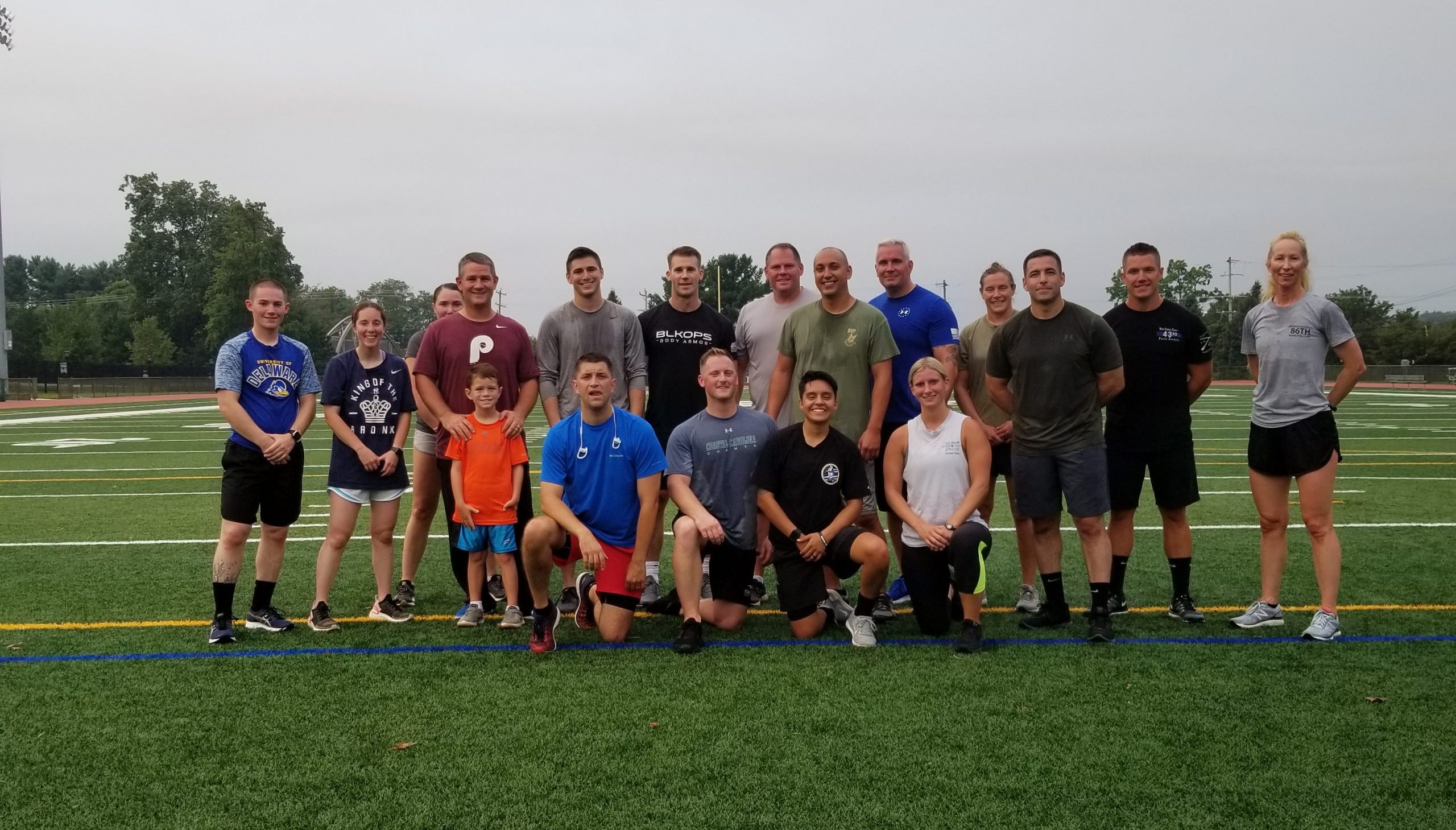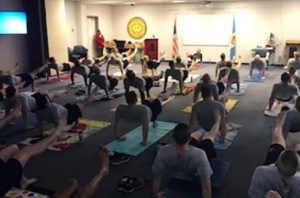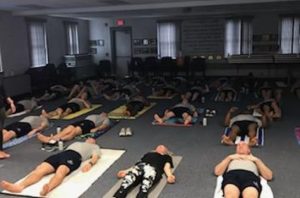Winston Churchill is credited with saying, “Never let a good crisis go to waste.” Churchill asserted that dramatic events and circumstances can furnish fresh insights and growth opportunities for the future.1 The year 2020 and the beginning of 2021 have certainly provided not just one but several crises to propagate new insights and development opportunities for law enforcement. The pandemic forced police professionals to grapple with personal safety concerns, new challenges in the family and home domain, and precautionary measures against the invisible and non-discriminating enemy: COVID-19. Simultaneously, civil unrest, discontent, calls for police reform, and transparency demands have added to the already overwhelming strains and constraints on police leaders and officers. Regardless of the past or what law enforcement will become in the future, the demand for police officers to respond to and assist communities will persist. However, in what physical, mental, and emotional conditions will those officers be when they show up if concerted steps are not taken to improve and enhance their wellness and resiliency?
Law enforcement leaders and members have faced some noticeable developments and challenges due to a global war on domestic and international terrorism, addiction and mental health issues in their communities, an increase in demands for police accountability, transparency and legitimacy issues, economic crises, shrinking budgets, and technological advancements. Undoubtedly, occupational-related stress and work-family conflict represents severe threats to police officers’ wellness and safety, especially considering the added challenges of 2020. For context, in 2020, 362 U.S. officers lost their lives in the line of duty, with 234 deaths related to COVID-19, compared to 150 line-of-duty deaths in 2019.2 Equally, disheartening is the number of officers who died by suicide. In 2020, Blue H.E.L.P. reported 173 officers died from suicide, with those numbers likely to increase as reporting continues.3 In a “normal” year, the demands on law enforcement are countless, but what will be the legacy of 2020 for officers’ mental health and wellness? The answer is a call for all chiefs, leaders, and organizations to act.
Stress
Research on occupational stress has been extensively investigated in the psychological, medical, and social science literature. It is a transactional concept that links stress sources (stressors) to individuals’ responses and coping mechanisms. Due to organizational culture, mandates, and the working environment, police occupational stress tends to be shaped daily by intertwined internal and external influences, mostly outside of the officers’ control. Early studies classified police stress into two categories: organizational and occupational. The former comes chiefly from the police organization’s nature, such as bureaucracy, work hours, and supervisor-subordinate relations. The latter arises from police work’s dangerous and unpredictable nature.4 Countless studies classify police work as one of the most stressful occupations that an individual can undertake. The stress that officers experience during their shifts does not end when their shifts end, but bleeds into their home lives, affecting their relationships with their significant others, children, family, and support networks.
Work-Family Conflict
For good or bad, policing isn’t just a career that stops at the end of a shift; it is a way of life that seeps into every part of an officer’s being. The past year has made the blur and division between work and family life even more distorted. A primary source of police stress is work-family conflict (WFC), which refers to “a form of interrole conflict in which the role pressures from the work and family domains are mutually incompatible in some respect. That is, participation in the work (family) role is made more difficult by virtue of participation in the family (work) role.”5 Many adults identify their family and work as central to their identities and lives, and police officers are no different.6 However, policing is unusual because the police mindset doesn’t shut down when officers walk into their homes at the end of a shift, nor does the psychological discomfort triggered by traumatic events at work. Working for a 24-hour agency such as the police exacerbates the strain between work and home through non-family-friendly policies and demands that places additional pressures on officers’ family lives and support networks. Research has shown that high levels of WFC are associated with negative consequences such as marital difficulties, decreased health, inadequate performance, reduced job and life satisfaction, psychological distress, burnout, and suicide ideation.7 The physical, mental, and never-ending emotional demands on police encompass occupational stress and organizational stress that intensify the strain between home and work.
Burnout
The outcome of prolonged chronic officer stress and WFC can be burnout. Burnout is a psychological syndrome comprising the three dimensions of exhaustion, cynicism, and inefficacy. Burnout can cause external and internal difficulties to employees, which can adversely affect their work and home lives. The burned-out officer tends to experience overall exhaustion, which is linked to symptoms of headaches, sleep disturbances, chronic fatigue, muscle tension, gastrointestinal disorders, hypertension, and depression.8 Externally, an individual with burnout may exhibit unfavorable work attitudes and behaviors, such as increased absenteeism, withdrawal, intentions to leave the job, inappropriate interactions with members of the public, and excessive force.9 In the most extreme situations, police officers have resorted to committing suicide to end the overwhelming stress and burnout.10
Resiliency
The preceding information is bleak and highlights the longstanding challenges of policing. In response to the demands of 2020 for officers and organizations, there is a solution. Research has proven that resiliency can be a mediating factor between officer stress, WFC, and burnout.11 Law enforcement resiliency can be referred to as “the capacity of agencies and officers to draw upon their individual, collective, and institutional resources and competencies to cope with, adapt to, and develop from the demands, challenges, and changes encountered during and after a critical incident, mass emergency, or disaster.”12 Resilient individuals are less negatively impacted by adverse events, tend to recover faster, and are more likely to experience post-event growth after the event. Resilient individuals possess three universal personality characteristics, including (1) control, which is the belief that they can exude influence over or have control over an event or experience and that they are not helpless; (2) commitment, which is the ability to feel deeply committed to or involved in the activities in their lives; and, (3) challenge, which signals officers’ views of change as an exciting challenge to further their development and growth opportunities, and not as a detriment; these individuals have confidence and a “bring-it-on” attitude.13 Individuals are not born resilient, but they can learn to develop resilience through life experiences and training. Resiliency can be taught, learned, developed, and reinforced. Research on military and police officers has shown that resiliency can be internalized and utilized and has profound positive effects on officer wellness, such as decreased PTSD, increased positive emotions, and constructive coping skills compared to individuals with less resilience.14
To increase resiliency, programs and resources should attempt to provide mental, physical, social, and spiritual growth opportunities for officers and their families. These recommendations include various programs and initiatives for behavioral health tools, specific training, peer support, and work-family balance initiatives. No single model or strategy works for every agency; however, taking even the smallest steps toward improving officers’ overall wellness, mental health, and resiliency can have significant effects and results. Leaders and agencies should not feel overwhelmed by past or current constraints to initiate new officer safety and wellness programs. Leaders and organizations can view past challenges as a launching board from which to vault into the realm of wellness and resiliency.
Recommendations
There are several steps that leaders and agencies can take to evaluate and initiate appropriate wellness and resiliency resources. Taking these steps ensures agencies will not waste time, energy, and money in identifying existing programs or new desirable programs.
-
- Needs Assessment
- Supportive Programs and Initiatives
- Training
- Leadership’s Role
Needs Assessment
So, where to start improving, enhancing, or initiating an officer safety and wellness program? A logical first step is to do an agency needs assessment survey of officers, non-sworn employees, and employees’ family members to learn what resources they are currently using (needs), what their struggles and issues are that are not being met (gaps), and what resources they desire (wants). Doing a needs assessment provides leadership and decision makers detailed information about the needs’ employees have.
The next step after a needs assessment survey is a total inventory of all existing resources and programs within the agency. These two evaluations will allow leaders to see the needs of employees and their families, what resources are currently available, how the resources are accessed or utilized, and what programs and resources are required to fill any gaps.
If an agency is concerned that the leaders don’t have the time, money, or expertise to conduct a needs assessment, there are low-cost and free options out there. There are numerous needs assessment survey templates available online; countless online survey platforms; and companies that specialize in creating, distributing, and analyzing results for a fee. Agencies can also seek out a local university or college for professional advice or a partnership. The first step is to see where officers, their families, and the agency are before blazing the path forward.
Supportive Programs and Initiatives
Once information has been gathered from the assessments, the next step is to formulate a plan on how to move forward and what to enhance or initiate first. There are a plethora of existing supportive programs, initiatives, and model policies—leaders do not need to start from scratch to research and create customized wellness programs for their agencies. They just need to know where to look and how to evaluate the options that best serve their officers, the officers’ families, and their agency. Fortunately, professional organizations such as the IACP and government agencies, including the Department of Justice, among other sources provide a variety of resources on best practices, model policies, scholarly research with real-life application strategies, and implementation success stories that can assist agencies with establishing a plan.
Understandably, no single program or model fits the needs of every officer and his or her family situation. The requirement for organization-level interventions in addition to supportive individual intervention is vital. Agencies also need to ensure multiple access entry points to wellness and mental health services, resources, and information. It is not enough to have only an agency-supported employee assistance program through the organization’s human resources department. Agencies need to create and support platforms with the appropriate services to meet employees and their families where they are, when they need the support, 24 hours a day.
To decrease stress, burnout, and WFC, agencies and leaders need to increase internal support, as peer support has been found to be a positive mediating factor, as well as a component of resiliency.15 Two meta-analyses studies reinforced the importance of peer support for first responders.16 Additional studies found that first responders who shared experiences with support networks had decreased stress and lower PTSD symptoms.17 Research proves that officers and policing culture have traditionally been resistant to asking for or accepting emotional support, as officers fear the stigma and the risk of it interfering with their ability (or the perception of their ability) to perform job duties or harming their reputation.18 Some officers prefer sharing and discussing challenging issues or events with others with similar backgrounds and experiences to their own, making peer support programs an advisable supportive option.19
Over the years, several supportive initiatives have been proven to provide a best practice framework for agencies. Supportive programs, such as peer support, chaplaincy programs, and spousal and family support programs, are just a few of the possible options for agency inclusion. In 2016, the IACP Police Psychological Services Section Ratified the Peer Support Guidelines to assist agencies in the development and implementation of peer support under the organizational structure of the agency. The guidelines are intended to provide recommendations on forming and maintaining a peer support structure within a law enforcement agency.20 In addition to police support networks, officers may also seek out non-police support networks; therefore, including family members and significant others in peer support programs helps the support individuals understand stressors and demands that officers may experience and provides officers’ non-peer supporters with resources. Programs that include how to survive and thrive on the job (stress management), financial counseling, relationship success, mindfulness, healthy habits and sleep and nutritional counseling, planning for retirement, and emotional health and support are all constructive possibilities. This educational, supportive outreach for officers’ support networks also helps bridge the divide and support individuals dealing with WFC. It’s important to ensure that family and spousal support is introduced in the recruiting and hiring process and sustained throughout employment, providing a long-term connection between officers’ families and their organizations.

Training
In addition to supportive programs, no successful agency program would be effective without proper training. Not only is the type of training important, but so is the timing. Law enforcement follows three categories of interventions: primary, secondary, and tertiary. Primary prevention focuses on bolstering officers’ resiliency and preparing officers for dealing with traumatic events. This prevention model follows law enforcement standard training models to train officers for future potential incidents to equip them with the knowledge, skills, and abilities to navigate incidents while being mindful of their mental health and emotional wellness. Secondary prevention techniques are developed to fend off stress-related disorders after personnel experience trauma.21 Critical incident stress debriefing (CISD) is likely the most widely implemented secondary prevention strategy. Tertiary prevention treats existing and established psychiatric symptoms. It is not an ideal first-line solution, as officers tend to underutilize these programs due to fear of stigma. Another positive of resiliency training is that it can and should be incorporated into all these categories of interventions.
Leaders should look for programs with a track record and history of utilization by other police departments of comparable size and type. What works for one agency might not work for another. Also, an essential component of program evaluation is the long-term benefits and success of the program within the agency. A one-time training should not be expected to generate long-term benefits and measurable success. The best plans are those that have long-term planning and implementation capabilities. With resiliency training, utilizing a program with a train-the-trainer component is a best practice for long-term success and cost and resource effectiveness. Having in-house trainers gives agencies the ability and flexibility to teach the course over the long term and in various environments without the restrictions of a one-time, one-day training session. By having internal agency trainers, resiliency instruction can be embedded not only in the formal classroom setting but during shift briefings, subordinate counseling sessions, in-service training, virtual or in-person training, leadership programs, first-line supervisors training, new employee orientation, and during CISD sessions. Train-the-trainer programs allow leaders to plan for the long term and create a legacy instead of a one-time training course.
Leadership’s Role
 |
 |
Police leaders and supervisors need to lead by example and from the front. Cultural change regarding mental health and wellness will require agency leader’s support, advocacy, and buy-in. Leadership and specific supervisory training are critical to change the existing perception and stigma around officers seeking out and utilizing mental health resources and tools to establish a mental wellness culture. Police leadership is key to reducing and ending the stigma associated with asking for mental health assistance. Leaders and organizations can decrease the stigma by openly speaking about mental health resources, normalizing their usage in daily conversations and in-service sessions, and by encouraging or requiring officers to utilize mental health services annually as part of other physical health and wellness initiatives.
Besides leading from the front and advocating for mental health awareness in various settings, leaders and agencies can incorporate customized mobile wellness app platforms to reduce or manage stress, burnout, and WFC. One of the most significant benefits of employing an agency wellness app is its 24 hours a day, 7 days a week, 365 days a year availability. The most all-inclusive mobile app platforms include anonymous self-assessments, instant feedback, educational guidance, customizable resources to connect users to peer support, current EAP benefits, and agency-vetted therapists. These platforms are skill-building opportunities for mindfulness, fitness, nutrition, and injury prevention to promote officers’ and families’ resilience in all aspects of their lives (mental, physical, social, and spiritual). Strong leadership is genuinely required to create a culture of officer wellness that encourages acknowledging, seeking, and accepting mental health interventions and strategies. These mental health resources can easily incorporate existing agency resources and new and enhanced ones through an engaging and accessible platform. This technology bridges the gap between what agencies have with what officers and families need and want in a single location.
Conclusion
Stress, WFC, and burnout can all have negative and fatal consequences for officers, their families, and their organizations. Churchill’s quote should stimulate police leaders to look for the silver lining of 2020, to seek opportunities, and embrace change. Let’s use 2021 to give officers the tools and resources they need to show up at their best at work and home. Leaders can transform the mental health and wellness culture within their organizations to assist officers, civilians, and their families in being ready and prepared to handle the next call, crisis, or day-to-day obstacle. The saying “stay ready, so you don’t have to get ready” epitomizes the mental health and wellness attitude that agencies should embrace. Leaders and organizations need to continue to take concerted steps to cultivate a culture of caring, wellness, health, and resiliency. Police officers are required to perform exceptional work daily, amid the most challenging of circumstances, scrutiny, and risks. The profession must continue to move the needle on officer safety and wellness in 2021 so that the crises, losses, and struggles of 2020 were not in vain.
Notes:
1“Never Let a Good Crisis Go to Waste,” FocusCFO (blog), May 27, 2020.
2Officer Down Memorial Page (ODMP), “Honoring Officers Killed in 2020”; ODMP, “Honoring Officers Killed in 2019.”
3Joshua Skovlund, “The Law Enforcement Death Count in 2020,” Black Rifle Coffee Company, January 12, 2021.
4Jennfier M. Brown and Elizabeth A. Campbell, “Sources of Occupational Stress in the Police,” Work and Stress 4, no. 4 (1990): 305–318.
5Jeffrey H. Greenhaus and Nicholas J. Beutell, “Sources of Conflict between Work and Family Roles,” Academy of Management Review 10, no. 1 (January 1985): 76–88.
6Noraini M. Noor, “Work-Family Conflict, Work-and-Family-Role Salience, and Women’s Well-Being,” The Journal of Social Psychology 144, no. 4 (August 2004): 389–405.
7Ronald J. Burke, “Some Antecedents and Consequences of Work-Family Conflict,” Journal of Social Behavior and Personality 3, no. 4 (1988): 287–302; Jennifer D. Griffin and Ivan Y. Sun, “Do Work-Family Conflict and Resiliency Mediate Police Stress and Burnout: A Study of State Police Officers,” American Journal of Criminal Justice 43, no. 2 (June 2018): 354–370; Jessica Mesmer-Magnus and Chockalingam Viswesvaran, “Convergence between Measures of Work-to-Family and Family-to-Work Conflict: A Meta-Analytic Examination,” Journal of Vocational Behavior 67, no. 2 (October 2005): 215–232; Aslaug Mikkelsen and Ronald J. Burke, “Work-family Concerns of Norwegian Police Officers: Antecedents and Consequences,” International Journal of Stress Management 11, no 4 (November 2004): 429–444.
8 Christina Maslach and Michael P. Leiter, “Burnout,” in Encyclopedia of Stress, ed. George Fink (San Diego, CA: Academic Press, 2000): 358–362.
9Maslach and Leither, “Burnout”; Phillip Neely and Craig S. Cleveland, “The Impact of Job-Related Stressors on Incidents of Excessive Force by Police Officers,” American Journal of Health Sciences 3, no. 1 (2012): 63–74.
10John M. Violanti, “Predictors of Police Suicide Ideation,” Suicide and Life-Threatening Behavior 34, no. 3 (2004): 277–283; John M. Violanti, Police Suicide: Epidemic in Blue, 2nd ed. (Springfield, IL: Charles C. Thomas, 2007).
11Griffin and Sun, “Do Work-Family Conflict and Resiliency Mediate Police Stress and Burnout.”
12Douglas Paton et al., “Stress Shield: A Model of Police Resiliency,” International Journal of Emergency Mental Health 10, no.2 (2008): 95–108.
13Suzanne C. Kobasa, “Stressful Life Events, Personality, and Health: An Inquiry into Hardiness,” Journal of Personality and Social Psychology 37, no. 1 (1979): 1–11; Laurence Miller, “Stress and Resilience in Law Enforcement Training and Practice,” International Journal of Emergency Mental Health 10, no. 2 (2008): 109–124.
14Ian de Terte, Christine Stephens, and Lynne Huddleston, “The Development of a Three Part Model of Psychological Resilience,” Stress Health 30, no. 5 (December 2014): 416–424; Isaac R. Galatzer-Levy et al., “Positive and Negative Emotion Prospectively Predict Trajectories of Resilience and Distress among High-Exposure Police Officers,” Emotion 13, no. 3 (June 2013): 545–553; Miller, “Stress and Resilience in Law Enforcement Training and Practice”; Angela Simmons and Linda Yoder, “Military Resilience: A Concept Analysis,” Nursing Forum 48, no. 1 (2013): 17–25.
15Gargi Roysircar, Building Community Resilience in Mississippi: Care for Disaster Response Workers and Caregivers (Keene, NH: Antioch University New England Multicultural Center for Research and Practice, 2008).
16Gobriele Prati and Luca Pietrantoni, “The Relation of Perceived and Received Social Support to Mental Health among First Responders: A Meta-Analytic Review,” Journal of Community Psychology 38, no. 3 (2010): 403–417.
17Tim Hoyt et al., “Disclosure of Emotional Events in Groups at Risk for Posttraumatic Stress Disorder,” International Journal of Stress Management 17 (2010): 78–95.
18John M. Violanti et al., “Police Stressors and Health: A State-of-the-Art Review,” Policing 40, no. 4 (November 2017): 642–656; Rachel Evans, Nancy Pistrang, and Jo Billings, “Police Officers’ Experiences of Supportive and Unsupportive Social Interactions Following Traumatic Incidents,” European Journal of Psychotraumatology 4 (2013).
19Judith A. Waters and William Ussery, “Police Stress: History, Contributing Factors, Symptoms, and Interventions,” Policing 30, no. 2 (2007): 169–188.
20IACP Police Psychological Services Section, “Peer Support Guidelines,” 2016.
21Matthew T. Feldner, Candice M. Monson, and Matthew J. Friedman, “A Critical Analysis of Approaches to Targeted PTSD Prevention: Current Status and Theoretically Derived Future Directions,” Behavior Modification 31, no. 1 (January 2007): 80–116.
Please cite as
Jennifer Griffin, “The Ultimate Call to Action: Leveraging the Crises of 2020 to Improve Officer Wellness and Resiliency,” Police Chief Online, May 11, 2021.



